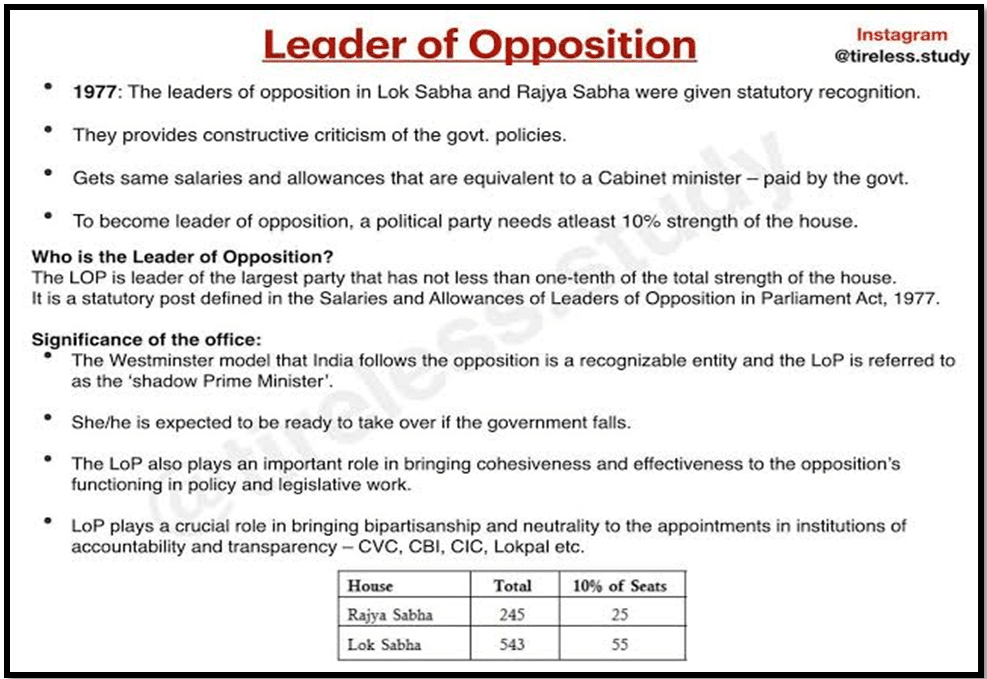OPPOSITION’S LARGER DEMOGRAPHY, LOP’S BIG RESPONSIBILITY
Syllabus:
GS 2:
- Indian Constitution—Evolution, and Features.
- Comparison of the Indian Constitutional Scheme with that of Other
Focus:
The appointment of the Leader of the Opposition (LoP) in the 18th Lok Sabha, amidst the largest numerical opposition, highlights parliamentary dynamics and the role’s historical significance in scrutinizing government policies and fostering democratic debate.
Source: Tireless
Historical Context
- Historic 2024 general election results in the largest Opposition in Lok Sabha history, with over 234 seats.
- Debate on the role of Leader of the Opposition (LoP) revived due to the numerical strength of the Opposition.
- Absence of LoP in 16th and 17th Lok Sabhas due to Speaker’s directive requiring 10% membership for party recognition.
- Introduction of Salary and Allowances of Leaders of Opposition in Parliament Act, 1977 defines LoP based on numerical strength and Speaker’s recognition.
- Impact of the 10% rule on LoP recognition and subsequent changes with the 10th Schedule rendering party categorization by strength irrelevant.
Understanding Leader of Opposition:
- Constitutional Absence: The office of Leader of the Opposition is not specified in the Indian Constitution.
- Recognition Criteria: The Leader of the Opposition in the Lok Sabha is recognized from the largest opposition party holding at least one-tenth of the total seats in the House.
- Committee Memberships: Holds positions in key parliamentary committees such as Public Accounts (Chairman), Public Undertakings, Estimates, and various Joint Parliamentary Committees.
- Selection Committee
Participation: Participates in selection committees responsible for appointing heads of statutory bodies like the CVC, CIC, CBI, NHRC, and Lokpal.
- Role in Governance: Provides constructive criticism of government policies and presents an alternative governance approach.
- Statutory Recognition: Statutory recognition under the Salaries and Allowances of Leader of Opposition in Parliament Act, 1977, entitling to salary, allowances, and facilities equivalent to a cabinet minister.
Role in the Westminster System
- Political Significance: In the British tradition, LoP is the Prime Minister-in-waiting, leading the shadow cabinet.
- Function of Shadow Cabinet: Scrutinizes government policies, offers alternative policies mirroring the real cabinet.
- Comparison with Indian system: India lacks a formal shadow cabinet despite adopting the Westminster system.
- Statutory Position: LoP’s role defined since 1977 without specific legislative functions.
- Traditional Role: LoP traditionally a senior member of the principal Opposition, critical of government policies.
Past Lessons and Future Outlook
- Lessons from Nehru: Nehru’s approach to listening to Opposition, enhancing parliamentary democracy.
- Restoring Normalcy: LoP crucial in restoring parliamentary norms, fostering constructive debate and dissent.
- Role in Questioning: Tradition of demanding Prime Minister’s presence, ensuring transparency and accountability.
- Historical Evolution: Early Parliament’s environment of tolerance towards dissent and diverse viewpoints.
- Future of Democracy: Upholding parliamentary traditions, learning from history to strengthen democratic practices.
Challenges and Responsibilities
- Diverse Opposition: Composed of multiple parties with divergent ideologies and programs, posing challenges to LoP’s role.
- Lack of Power: LoP lacks direct power, reliant on opposing government policies and attempting to unify opposition parties.
- Impact of Majority: Previous weak opposition contrasted with strengthened role post-2024 election with over 234 Opposition members.
- Influence in Parliament: Increased numbers allow for greater impact on debates, question sessions, and legislative scrutiny.
- Leadership Responsibilities: LoP tasked with uniting the Opposition, presenting views effectively, and holding government accountable.
Understanding Westminster Model
Characteristics:
|
Way Forward
- Legislative Reform: Amend existing laws to redefine Leader of the Opposition (LoP)’s role with specific legislative functions.
- Formation of Shadow Cabinet: Implement a formal shadow cabinet system to mirror government functions and enhance policy scrutiny.
- Parliamentary Protocol: Establish protocols for regular interaction between LoP and Prime Minister to foster constructive dialogue.
- Capacity Building: Invest in training and capacity-building programs for Opposition members to enhance their parliamentary effectiveness.
- Public Awareness: Educate the public on the importance of a strong Opposition in maintaining checks and balances within democracy.
- Constitutional Review: Review constitutional provisions related to LoP to ensure relevance in contemporary parliamentary practices.
- International Best Practices: Study and adopt best practices from other parliamentary systems to strengthen India’s democratic framework.
- Civil Society Engagement: Foster partnerships with civil society organizations to promote transparency and accountability in parliamentary proceedings.
Conclusion
The role of the Leader of the Opposition (LoP) in India’s parliamentary system is pivotal, especially in the context of a significant opposition presence. Upholding traditions of dissent and oversight, the LoP plays a crucial role in ensuring accountability and balanced governance.
Source:The Hindu
Mains Practice Question:
Discuss the significance of the Leader of the Opposition (LoP) in the Indian parliamentary system. How does the LoP’s role contribute to the functioning of democracy, especially in the context of a diverse and numerically large opposition.
Associated Article:




